Wen-Amun
Wen-Amun: Egyptian diplomat, famous for his misadventurous voyage to Byblos in the early eleventh century BCE.
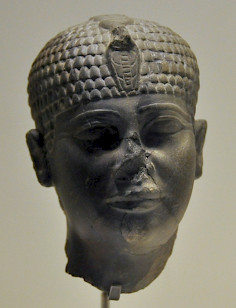
Wen-Amun is known from an incomplete papyrusnote that was found during clandestine excavations, probably in 1890, in El-Hiba in Middle Egypt. This town, ancient Tayu-djayet, used to be the hometown of Herihor, who would be high priest of Amun in Thebes during the reign of Ramesses XI (r.1098-1069 BCE), the last king of the Twentieth Dynasty. Although the provenance of the Wen-Amun Papyrus is unknown, there are no doubts about its authenticity.
The text, written in hieratic (simplified hieroglyphs), describes the voyage of Egyptian courtier Wen-Amun, who had to buy wood in Byblos. Everything that can go wrong, goes wrong, and we do not know whether the document was intended as an official report or a funny literary story about a clumsy diplomat. The answer to this question is important, because the story offers evidence for Egypt’s diminishing influence in the Near East, and this evidence may be reliable or unreliable, depending on one’s view of the official or literary nature of the text.
Another problem is the date of the voyage of the unfortunate diplomat. The text says it started in the fifth year, but the king is not mentioned. Most scholars, however, believe that Ramesses XI is meant, which creates two other problems, because we do not know this king’s first regnal year (“1098-1069” is just one possibility) and, worse, this pharaoh proclaimed a new era and started a recount of his regnal years. So, there are two fifth years, which may or may not be 1094 and 1080 BCE. Usually, the second fifth year is accepted, but there are alternative theories and it must be stressed that other kings are possible as well.
Background
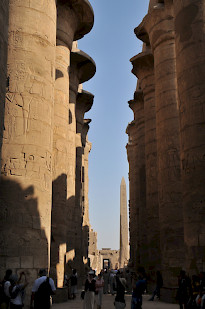
In any case, Egypt was no longer the superpower it had been. During or shortly after the reign of Ramesses VI (r.1142-1134), it had lost its possessions in Canaan. Internally, Egypt was divided, with four kings named Ramesses ruling in just one generation. The country completely disintegrated during the reign of Ramesses XI, who became king in 1098 and died in 1069 (although, as indicated, these dates are contested).
After his death, the unity of Egypt simply vanished. In the north, Nesbanebdjed or Smendes had already started to act quite independently. He was the first ruler of the Twenty-first Dynasty, while in the south power was exercised by the high priest of Amun in Thebes. This was the Herihor mentioned above. All rulers appear to have been on friendly terms.
It was in Thebes, in an unknown year in the early eleventh century BCE, that the barque carrying the cult statue of Amun was ready for replacement. Herihor sent out Wen-Amun to get cedar wood.
To Byblos
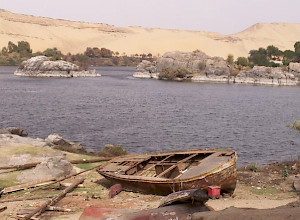
According to the papyrus, Wen-Amun, the “eldest of the hall of the sanctuary of Amun” in Thebes, left his city “on the sixteenth day of the third month of the third season of the fifth year” to “bring the timber for the great and august barque of Amun-Re, the king of the gods”.
He sailed downstream along the Nile and reached Tanis, where he handed over his letters of recommendation to Nesbanebdjed, who offered to help him and sent his guest to a captain, who was to bring him to Byblos, which must have been an important trade center for wood from the cedar tree.
The ship first brought him to Dor, a port in what now called Israel. Since the collapse of Egyptian power, this town was controlled by the Tjeker, one of the Sea People that had been defeated and resettled by Ramesses III a century before. Although king Beder received his Egyptian guest friendly, things went terribly wrong.
A man from my ship fled, having stolen a vessel of gold, amounting to five deben,note four vessels of silver, amounting to twenty deben, and a sack of silver, amounting to eleven deben. Together, he took away five deben of gold and thirty one deben of silver.

Wen-Amun explained his situation to king Beder and demanded to be repaid by the man who was responsible for law and order.
“It was in your harbor that I have been robbed and because you are king in this land, you must investigate this case and search for my valuables. For they belong to Amun-Re, the king of the gods and the lord of the lands. They belong to Nesbanebdjed and to my lord Herihor. … They are meant for Zakar-Baal, the ruler of Byblos.”
It was customary that the lord of a place would compensate the victims of a crime, but the king of Dor was of a different opinion.
“If the thief lived in my land and went aboard of your ship to steal your treasures, I would certainly repay you from my treasure until the thief had been caught, but the man who robbed you belongs to your own ship. However, stay a couple of days over here, so that I may investigate the case.”
The thief was not found, while Wen-Amun and king Beder still disagreed about the king’s liability. After a week, Wen-Amun decided to continue to Byblos, although he had not been compensated. Even with some diplomatic presents less, he must have thought, he would obtain the timber.
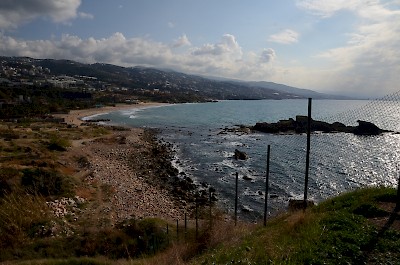
As it happened, he was lucky, because at sea his ship met one of the ships of the Tjeker. The Egyptian diplomat, who maintained that the Tjeker still owed him money, helped himself to thirty deben of silver. Without further complications his ship passed Tyre, Sidon, and Berytus, and reached Byblos, where he said goodby to his captain, set up his tent near the harbor, and buried the money, together with a statuette of Amun that he believed to protect his voyage.
Negotiations in Byblos
Wen-Amun soon discovered that he was not as welcome as he had expected. There had been a time when a king of Byblos would have been happy to send timber for the barque of Amun in faraway Thebes, but Egyptian power had collapsed and king Zakar-Baal of Byblos ordered Wen-Amun to leave. Of course the king knew what the Egyptian visitor was to answer – that the ship from Egypt had already left and that there was no way to return to Egypt.
On the next day, Wen-Amun received the same order and gave the same answer. It is obvious that Zakar-Baal knew that Wen-Amun wanted something from him and suspected that the Egyptian was not willing to pay what the king of Byblos believed to be the full price. Ordering his visitor to leave may have been a way to weaken Wen-Amun’s bargaining power. After several weeks with the same messages from the palace to the port and from the port to the palace, something happened.
When Zakar-Baal was sacrificing to his gods, a god seized a young nobleman, brought him into a frenzy, and made him shout “Bring the god here! Bring the messenger of Amun who has his statue! Order him to come hither!”
This is remarkable, because this type of divine ecstasy is rarely mentioned in Egyptian sources, while it is known from Canaanite religion. This suggests some basic reliability in the story of Wen-Amun. However that may be, the Egyptian diplomat knew how to negotiate: now that the people of Byblos needed him, he explained that a ship from Egypt had just arrived, that he was about to leave, that he had already carried his luggage on board.
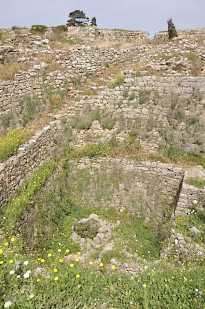
This may have been true, but in any case, Wen-Amun accepted the invitation and next day, he climbed up the hill, to the royal palace. (He may already have known the palace, because in Egyptian myth, this was the place where the goddess Isis found one of the parts of the dead body of her husband Osiris.) The meeting with the king soon turned awkward.
The king said to me: “Behold, if you are a real diplomat, where is the letter of recommendation from Amun, where is the letter of the high priest of Amun?”
I said to him: “I gave them to Nesbanebdjed and [his colleague] Tentamon.”
He became very angry and said to me: “So, you have no letter of recommendation.”
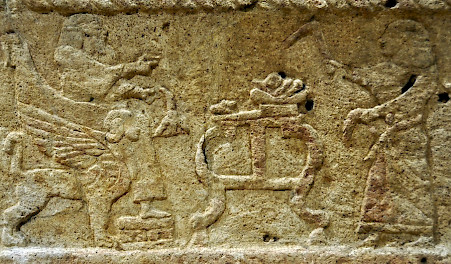
Worse, the king soon found out that Wen-Amun had not attempted to obtain a letter of recommendation, even though there were ships from Byblos that might have carried a request to Egypt. Wen-Amun could only admit he had no papers and had done nothing to obtain them.
I was silent. The king said to me: “Which business brought you here?”
I replied: “I have come to get timber for the great and august barque of Amun-Re, the king of the gods. Your father gave it, your grandfather gave it, and you will also give it.”
That is what I said and he said to me: “That is true, they gave the timber. If you pay me something, I will give it to you as well. Indeed, my servants have recorded the business. The pharaoh used to send six ships, laden with the products of Egypt, which were brought to the storerooms of Byblos. You must also bring something for me.”
He had the records of his ancestors brought in and ordered them to be read. The books mentioned one thousand deben of every kind of silver.
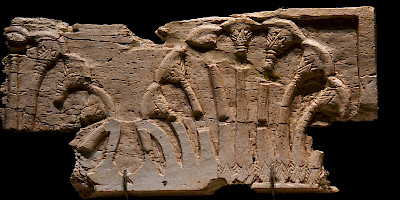
Wen-Amun explained that these were not payments and that he suspected they had been presents for special occasions. It is obvious that he believed that the situation was still as it used to be, when a powerful Egypt could demand everything it wanted, including cedar wood in exchange for some diplomatic gifts. On the other side stood a proud Zakar-Baal, a man of the new age, who understood the reality: Egypt was in decline and could be forced to do business like all other nations.
Doing Business
Although Zakar-Baal was making a point about Wen-Amun’s lack of credibility, the king of Byblos did not want his guest to return empty-handed, because then he hadn’t sold anything. So, a compromise was found: Zakar-Baal sent some timber to Egypt and allowed Wen-Amun to send a messenger with a letter, asking for money. In Egypt, Nesbanebdjed responded swiftly and sent four vessels of gold, one vase of gold, five vessels of silver, ten garments of royal linen, ten garments of fine linen, five hundred scrolls of papyrus, 500 ox-hides, 500 coils of rope, twenty measures of lentils, thirty baskets of fish. Wen-Amun’s wife added some presents as well.

It must have been less than the six ships Zakar-Baal had demanded, but at least they were now doing business.
The king sent 300 men and 300 oxen, chose overseers, and had the trees felled. The workers spent the second season in the mountains. In the third month of the second season, they dragged the timber to the shore of the sea.
Although the timber was there, and although Wen-Amun must have been hoping to return home soon, Zakar-Baal put some additional pressure on him. Perhaps his guest was willing to pay more. Earlier Egyptian diplomats, the king said, had died in Byblos. Wouldn’t Wen-Amun like to see their tombs? Wen-Amun ignored the implied threat and countered with a proposal of his own: wouldn’t it be better if his host dedicated a nice inscription to Amun, in which he explained that he had obeyed the god’s wishes? “What a noble proposal,” the king sarcastically replied.
New Problems
The negotiations were still in an impasse when eleven ships arrived: Tjeker from Dor, who wanted the money back that Wen-Amun had seized (above). This was not something for which king Zakar-Baal was prepared. Putting pressure on a diplomat was one thing, a major diplomatic incident in his own harbor was something far more serious. The Egyptian had to leave, had to leave immediately. To make sure Wen-Amun would indeed leave, Zakar-Baal broke off the negotiations and gave his guests farewell presents.
He sent his scribe to me with two jars of wine and a ram, together with an Egyptian courtesan, who has received orders: “Sing for him! Let his heart feel no sorrow.”
Next day, king Zakar-Baal met the Tjeker and explained that he could not arrest a messenger of Amun, who had diplomatic immunity. Still, he was willing to extradite the Egyptian, allowing the Tjeker to pursue at sea and arrest him. While he was talking to the Tjeker, Wen-Amun had already left Byblos, not sailing to the south, to Egypt, which would bring him past Dor, but sailing to the west, to Cyprus.
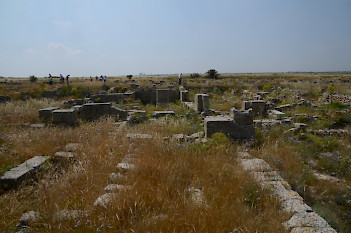
The papyrus calls the Cypriote city Alashiya, which has been identified with Enkomi on the eastern shore of the island, although there is some doubt about this identification. In any case, Wen-Amun was not yet safe.
The inhabitants wanted to lynch me and brought me to the palace of the queen of that city. I found her when she was leaving one part of the palace and entering another. I saluted her and asked to her servants: “Is there someone speaking Egyptian?”
One of them responded: “I do.”
I said to him: “Tell my queen that I have heard, even as far away as in Thebes, the city of Amun, that in every city injustice is done, except for the land of Alashiya, where justice is done. Still, I have been treated unjustly.”
The queen intervened and allowed him to stay in her palace – and that is the point where the papyrus breaks off. We do not know what happened next.